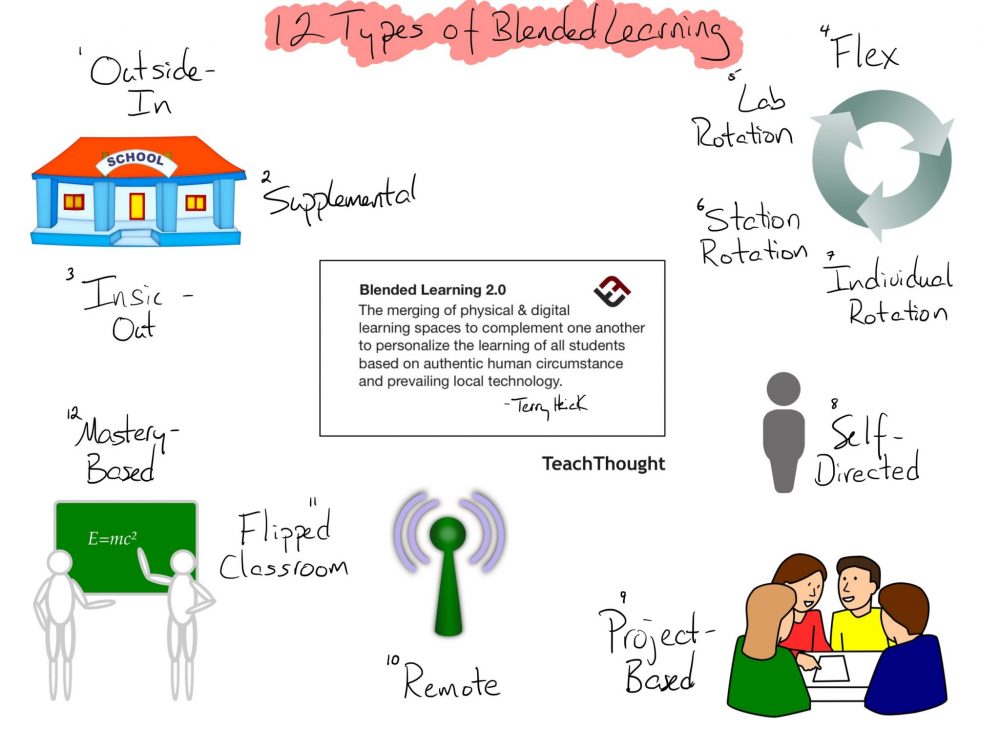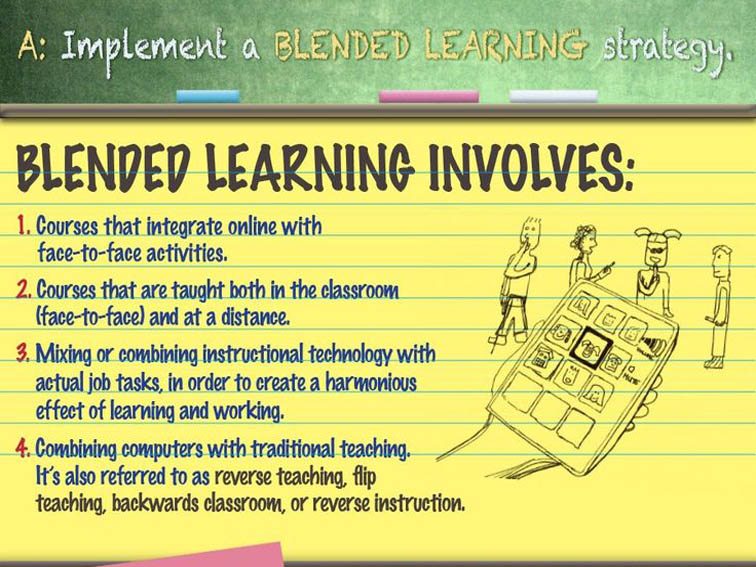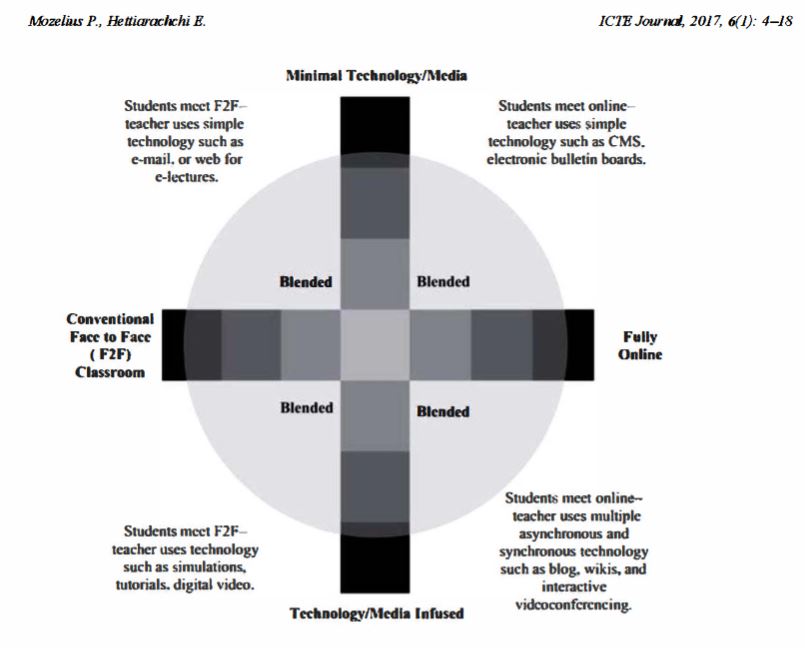Searching for "blended"
Development of the Online and Blended Teaching Readiness Assessment (OBTRA)
https://www.frontiersin.org/articles/10.3389/feduc.2021.673594/full
Readiness for teaching online has been defined as the qualities or predispositions of an instructor that exemplify teaching high-quality online courses (Palloff and Pratt, 2011). Mental and physical preparedness (Cutri and Mena, 2020), a willingness to create active, collaborative learning environments that foster a sense community (Palloff and Pratt, 2011), and acceptance of online teaching (Gibson et al., 2008) also demonstrate readiness for the online teaching and learning modality. An inability or unwillingness to adopt student-focused approaches and the perception that online courses provide low quality learning environments (Gibson et al., 2008) and are not worthwhile (Allen and Seaman, 2015) can be important barriers to the successful transition to teaching online.
Find The Model That Works For You: 12 Types Of Blended Learning
12 Of The Most Common Types Of Blended Learning


+++++++++++++
more on blended learning in this IMS blog
https://blog.stcloudstate.edu/ims?s=blended+learning
Critical Factors for Implementing Blended Learning in Higher Education.
Available from: https://www.researchgate.net/publication/318191000_Critical_Factors_for_Implementing_Blended_Learning_in_Higher_Education [accessed Jul 6, 2017].
Definition of Blended learning
Blended learning is in one dimension broadly defined as “The convergence of online and face-to-face Education” as in the study by Watson (2008). At the same time it is important to also include the dimension of technology and media use as it has been depicted in the multimodal conceptual model in Figure 1 below. This conceptual model was proposed and presented in an article published by Picciano (2009). Critical Factors for Implementing Blended Learning in Higher Education.

online face to face hybrid
Several studies that argue for the need to focus on pedagogy and learning objectives and not solely on technology (Hoffinan, 2006; Garrison & Vaughan, 2008; Al amm ary et al., 2014; McGee & Reis, 2012; Shand, Glassett Farrelly & Costa, 2016). Other findings in this study are that technology still is a critical issue (So & Brush, 2008; Fleming, Becker & Newton, 2017), not least in developing regions (AI Busaidi & Al-Shihi, 2012; Raphae1 & Mtebe, 2016), and also the more positive idea of technology as a supporting factor for innovative didactics and instructional design to satisfy the needs in heterogeneous student groups (Picciano, 2009). Critical Factors for Implementing Blended Learning in Higher Education.
Critical factors:
- technology
- didactics – pedagogy, instructional design and the teacher role
- Course outcomes – learning outcomes and learner satisfaction
- collaboration and social presence
- course design
- the heritage from technology enhanced distance courses
- multimodal overload
- trends and hypes
- economy
Blended learning perspectives
- the university perspective
- the Learner perspective
- the Teacher perspective
- the Global perspective
++++++++++++++++++++
more on blended learning in this IMS blog
https://blog.stcloudstate.edu/ims?s=blended+learning
Dr. Baiyun Chen, OLC Institute faculty for the Blended Learning Mastery Series: Research into Practice, joins us to discuss the future of blended learning in higher education
https://onlinelearningconsortium.org/insights-field-future-blended-learning/?mkt_tok=eyJpIjoiWWpNNU1qYzBaV1kwTnpGaiIsInQiOiJXWGJKc2g5anlpcGpUczhRMjRUUWhBYmk2N25HWjFCRW1RbjdJc2tpNnJ3eEIzREpoT29rZWtPM0ZIOHk5aTJzMDFvODBTNGJLNDJvaFZnVWJUYlVZcE8wU0sySXpRbGpnY0xHWTZCMkhOczNYNmg2TmNna01OZVo3dmFKNmVQZyJ9
The design of blended learning curriculum will be more diversified and personalized with the integration of creative in-class active learning strategies and innovative educational technologies, such as adaptive learning, virtual reality, mobile technologies
Quality assurance is the biggest challenge with implementing blended learning in the higher education environment today. I would propose institutions to adopt evidence-based standards for course evaluations. For instance, the OLC Quality Scorecard for Blended Learning Programs
+++++++++++++++++++
more on blended learning in this IMS blog
https://blog.stcloudstate.edu/ims?s=blended+learning
Wang, Q., Quek, C., & Hu, H. (2017). Designing and Improving a Blended Synchronous Learning Environment : An Educational Design Research. International Review of Research in Open and Distributed Learning, 18(3), 99-118
http://www.irrodl.org/index.php/irrodl/article/view/3034/4142
Definition: blended synchronous learning has attracted much attention and it is often labelled with synchronous hybrid learning (Cain & Henriksen 2013); synchronous blended learning (Okita, 201 3 ); multi – access learning (Irvine, Code, & Richards, 2013); or simultaneous delivery of course s to on – campus and off – campus students (White et al ., 2010). Adapted from the definition given by Bower , Dalgarno, Kennedy, Lee, and Kenney (2015), blended synchronous learning in this paper is defined as a learning method that enables online students to participate in classroom learning activities simultaneously via comput er – mediated communication technologies such as video conferencing . By following this approach , on – campus students attend F2F le ssons in the physical classroom. M eanwhile, online students who are situated at multiple sites participate in the identical class room learning activities via two – way video conferencing in real time .
With regard to educational benefits , blended synchronous learning can help to establish rich teaching presence, social presence, and cognitive presence ( Garrison, Anderson, & Archer, 200 0 ; Szeto, 2015 ). A BSLE provides a mimic classroom environment (White et al. , 2010) , where teachers ’ direct instruction and facilitation can be easily carried out a nd the teaching presence is hence naturally established.
Blended, Online Learning Innovation Grants Up for Grabs
By Dian Schaffhauser 04/18/17
https://thejournal.com/articles/2017/04/18/blended-online-learning-innovation-grants-up-for-grabs.aspx
Last year, the Foundation for Blended and Online Learning issued grants of up to $10,000 to seven recipients.
“overcome achievement gaps, drive engagement and personalize learning”
The funding, which goes the school, not the individual recipient, is expected to be used for technology, professional development, curriculum and related resources.
++++++++++++++
more on blended learning in this IMS blog
https://blog.stcloudstate.edu/ims?s=blended+learning
The Definition Of Blended Learning
January 18, 2013 http://www.teachthought.com/learning/blended-flipped-learning/the-definition-of-blended-learning/
the Sloan Consortium defined hybrid courses as those that “integrate online with traditional face-to-face class activities in a planned, pedagogically valuable manner.” Educators probably disagree on what qualifies as “pedagogically valuable,” but the essence is clear: Hybrid education uses online technology to not just supplement, but transform and improve the learning process.
++++++++++++++++++
more on blended / hybrid learning in this IMS blog
https://blog.stcloudstate.edu/ims?s=blended
https://blog.stcloudstate.edu/ims?s=blended+learning

+++++++++++++++++++++++
more on blended / hybrid learning in this IMS blog
https://blog.stcloudstate.edu/ims?s=blended
https://www.pinterest.com/pin/175499716709819945
http://www.gettingsmart.com/2013/09/120-top-articles-on-blended-learning/
125 Top Blogs on Blended Learning
++++++++++++++++
more on blended learning in this IMS blog
https://blog.stcloudstate.edu/ims?s=blended+learning
Thursday, March 2nd, 2017 at 3:00 pm ET
Join the Blended Librarians Online Learning Community for the second webcast in a series of conversations with Blended Librarians. This session explores the role of Blended Librarians by discussing with our panel how they developed their skills, how they obtained their positions, what their work is like, what their challenges are and what they enjoy about being a Blended Librarian. This panel conversation takes place on Thursday, March 2, 2017 at 3 p.m. EST with our guests J. Lindsay O’Neill, Francesca Marineo, Kristin (Miller) Woodward, Julie Hartwell, and Amanda Clossen.
Panelists
- Lindsay O’Neill is the Instructional Design Librarian at California State University, Fullerton’s Pollak Library, where she designs and develops tutorials related to information literacy and library research using Articulate Storyline, Adobe Captivate, and Camtasia. She is also a faculty member in CSUF’s Master of Science in Instructional Design and Technology program. Lindsay regularly consults on effective pedagogy, instructional design, educational technology, open licensing, and accessibility. Lindsay holds a Master in Education, specializing in Educational Technology/Instructional Design, as well as a Master of Library and Information Science.
- Francesca Marineo is an instructional design librarian at Nevada State College. She received her MLIS from the University of California, Los Angeles, where she discovered her profound passion for information literacy instruction. Currently pursuing a Master in Educational Psychology, she focuses on improving teaching and learning in higher education through innovative pedagogy and data-driven design.
- Kristin Woodward is Online Programs and Instructional Design Coordinator at UWM Libraries. In this role Kristin consults with faculty and teaching staff to build information competencies and library resources into the framework of online, hybrid and competency based courses. Kristin also serves as the campus lead for the student-funded Open Textbook and OER Project as well as the library team lead for Scholarly Communication.
- Julie Hartwell is an Instructional Design Librarian at the University of Missouri-Kansas City’s Miller Nichols Library. She serves as liaison to the Sociology, Criminal Justice, and Instructional Design departments. She contributes to the creation of library learning objects and instruction for the library’s Research Essentials program. She is a content creator and instructional designer for the New Literacies Alliance, an inter-institutional information literacy consortium. Julie is a Quality Matters Peer Reviewer. She received her masters of library and information science from the University of Iowa.
- Amanda Clossen has been working as the Learning Design Librarian at Penn State University Libraries for the past five years. In this position, she has worked on projects spanning the micro to macro aspects of learning design. She has created award-winning videos, overseen Penn State’s transition from an in-house guide product to LibGuides, and was deeply involved in integrating the Libraries in the new LMS, Canvas. Her research interests include accessibility, video usability, and concept based teaching.
+++++++++++++++
more on blended librarian in this IMS blog
https://blog.stcloudstate.edu/ims?s=blended+librarian



